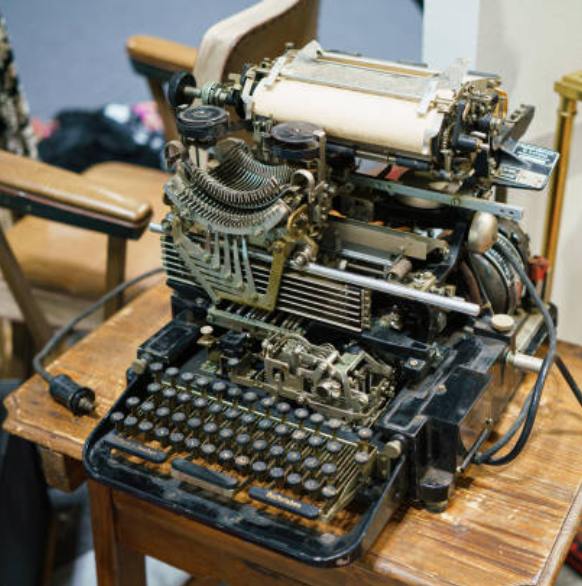This fascinating machine was described last week as a “second-hand typewriter” and was on display at the Antik Passion Almoneda, an annual antiques, art and collectors fair at IFEMA (Institución Ferial de Madrid) in Spain. It is, I believe, a mid-1930s teletypewriter, a 60lb “Telegraph Lo15” made by C. Lorenz AG. Richard Polt posted on acquiring one these models on his TheTypewriter Revolution blog in January 2014 (he had sold it by last October).
C. Lorenz AG was a German electrical and electronics firm in Berlin which developed products for electric lighting, telegraphy, telephony, radar and radio. Formed as C. Lorenz Telegraphenbauanstalt by Carl Lorenz in 1880, it was acquired by Stamford, Connecticut-based International Telephone & Telegraph in 1930 and became part of Standard Elektrik Lorenz (SEL) Stuttgart in 1958 when it merged with Standard Elektrizitätsgesellschaft and several other smaller companies owned by ITT. In 1987, SEL merged with the French companies Compagnie Générale d'Electricité and Alcatel to form the new Alcatel SEL.
In 1924 C. Lorenz AG acquired a license from the Chicago company Kleinschmidt-Morkrum (from 1928 known as Teletype Corp) to make a 5-bit Baudot type pressure telegraph machine based on Kleinschmidt-Morkrum’s Models 14 and 15 KSR (keyboard send and receive, the latter above). Production in Germany started in 1929 with developments of the licensing models.
The Morkrum Model 12 typebar page printer (above) was based on Underwood typewriter mechanism. It was produced from 1922-25 under the Morkrum company name, from 1925-29 under the Morkrum-Kleinschmidt name, and from 1929-43 under Teletype Corp. On December 23, 1924, Howard Krum and Sterling Morton filed an application on the 14-type typebar tape printer which matured into patent #1,745,633.
The Teletype Model 15 (above) was a Baudot code page printer, the mainstay of US military communications in World War II. In 1930 Morton, Krum and Edward E. Kleinschmidt filed an application for a US patent covering the commercial form of the Model 15 page printer. This is the Teletype machine that was used by news wire services until the 1970s. About 200,000 were built. The Model 15 remained in production until 1963, 33 years of continuous production. The Model 15, in its “receive only” configuration with no keyboard, was the classic “news Teletype”. Radio stations still use a recording of the sound of these machines as background during news broadcasts.
As for ITT, its chief executive Sosthenes Behn and his German representative, Henry Mann, met with Hitler on August 3, 1933. In Wall Street and the Rise of Hitler, Antony C. Sutton claimed ITT subsidiaries made cash payments to SS leader Heinrich Himmler. ITT, through the subsidiary C. Lorenz AG, owned 25 per cent of Focke-Wulf Flugzeugbau AG, the German aircraft manufacturer, builder of some of the most successful Luftwaffe fighter aircraft. In the 1960s, ITT won $27 million in compensation for damage inflicted on its share of the Focke-Wulf plant by Allied bombing during World War II. Sutton also uncovered that ITT owned shares of Signalbau Huth, which produced for the German Wehrmacht radar equipment and transceivers. While ITT-Focke-Wulf planes bombed Allied ships and ITT lines passed information to German submarines, ITT direction finders were saving other ships from torpedoes. In 1943 ITT became the largest shareholder of Focke-Wulf Flugzeugbau for the remainder of the war, with 29 per cent.







2 comments:
I still think it would be great to use a teletype to send and receive messages ... but my skills just weren't up to it.
When I began my newspaper career in the 1970s, the AP teletypes would output a readable paper copy as well as punched tape that was fed into a Linotype compositor (for a hot metal press) and later a Compugraphic typesetter for offset. Some of the old pros could read the punched tape just by looking at it.
Later, Selectric II typewriters with an OCR ball were used in the newsroom and the reporter's copy was fed into a large optical character recognition machine, which produced punched tape.
Post a Comment